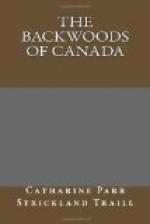We had a remarkable instance of smut in our corn last summer. The diseased cobs had large white bladders as big as a small puff-ball, or very large nuts, and these on being broken were full of an inky black liquid. On the same plants might be observed a sort of false fructification, the cob being deficient in kernels, which by some strange accident were transposed to the top feather or male blossoms. I leave botanists to explain the cause of this singular anomaly; I only state facts. I could not learn that the smut was a disease common to Indian corn, but last year smut or dust bran, as it is called by some, was very prevalent in the oat, barley and wheat crops. In this country especially, new lands are very subject to the disease.
The ripe corn is either shocked as beans are at home, or the cobs pulled and braided on ropes after the manner of onions, and hung over poles or beams in the granaries or barns. The stripping of the corn gives rise among some people, to what they call a husking-bee, which, like all the other bees, is one of Yankee origin, and is not now so frequently adopted among the more independent or better class of settlers.
The Indian corn is a tender and somewhat precarious crop: it is liable to injury from the late frosts while young, for which reason it is never put in before the 20th of May, or beginning of June, and even then it will suffer; it has also many enemies; bears, racoons, squirrels, mice, and birds, and is a great temptation to breachy cattle; who, to come at it, will even toss down a fence with stakes and riders for protection, i.e. a pole or cross-bar, supported between crossed stakes, that surmounts the zig-zag rail fences, for better securing them from the incursions of cattle.
Even in Canada this crop requires a hot summer to ripen it perfectly; which makes me think Mr. Cobbett was deceiving the English farmer when he recommended it as a profitable crop in England. Profitable and highly useful it is under every disadvantage, as it makes the richest and sweetest food for all kinds of granivorous animals, even in its green state, and affords sound good food when ripe, or even partially ripe, for fattening beasts and working oxen.




